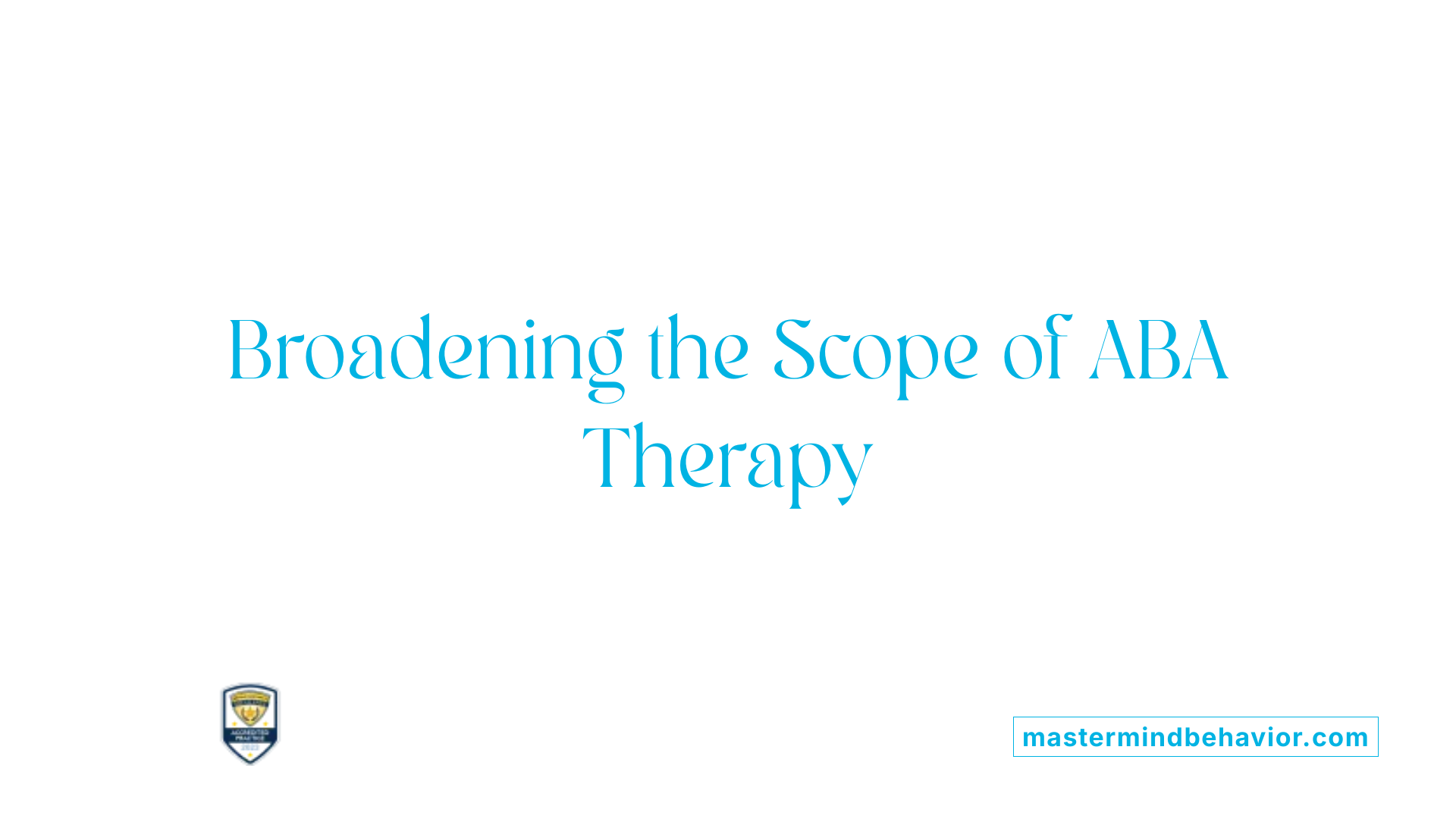How ABA Therapy Can Help Children Express Needs and Preferences

Understanding ABA Therapy's Role in Communication
Applied Behavior Analysis (ABA) therapy plays an instrumental role in assisting children with autism to express their needs, preferences, and desires. Through structured interventions tailored to each child's unique communication barriers, ABA offers a dynamic approach to improving expressive and receptive language skills. This article explores how ABA therapy not only supports skill development but also fosters self-advocacy and enhanced social interactions for children facing communication challenges.
The Core of ABA Therapy

What is ABA therapy for autism?
Applied Behavior Analysis (ABA) is a therapy grounded in the principles of learning and behavior, specifically tailored for individuals with autism. Its primary objective is to foster helpful behaviors while diminishing harmful ones. This is achieved through structured interventions centered around improving vital skills such as communication, social interactions, and academic abilities.
ABA therapy emphasizes personalized treatment plans. These plans are crafted by a Board Certified Behavior Analyst (BCBA), taking into account each child's unique skills and preferences. The therapy is versatile and can be implemented across various settings, including home and school environments, providing flexibility to families.
How does positive reinforcement work in ABA therapy?
Positive reinforcement is at the heart of ABA techniques—it serves to encourage desirable behaviors by rewarding them. For example, when a child correctly uses a word to express a need, they receive praise or a small reward. This method not only reinforces the behavior but also aids in skill generalization, making it more likely that the child will continue to use verbal communication in different situations, thus enhancing their overall communication abilities.
Why are tailored interventions important?
Tailored interventions are essential in ABA therapy as they address the specific needs of each child. Assessments are conducted to create a customized treatment strategy, ensuring that each session targets communication goals effectively. This individualized approach allows for ongoing adjustments based on the child’s progress, empowering them to express their needs and preferences more clearly.
| Component of ABA | Description | Benefits |
|---|---|---|
| Foundational Principles | ABA is based on developing desirable skills through understanding behavior and modifying it. | Improved communication and social skills. |
| Positive Reinforcement | Encouraging specific behaviors by rewarding them to ensure durability. | Increased likelihood of repeating positive behaviors. |
| Tailored Interventions | Customized strategies designed to cater to the individual strengths and needs of the child. | Enhanced effectiveness of therapy and skill acquisition. |
Techniques That Transform

What are some techniques used in ABA therapy?
Applied Behavior Analysis (ABA) therapy employs a variety of targeted techniques designed to improve communication skills and foster independence in children with autism. Here are three significant methods:
Positive Reinforcement
- This foundational strategy involves rewarding a child for displaying desired behaviors, which increases the likelihood of those behaviors being repeated. For example, when a child successfully asks for a toy using words, they might receive the toy or praise, reinforcing this form of communication.
Prompting
- Prompting serves as an essential support mechanism that provides children with cues to initiate the correct behavior or communication response. Gradually reducing prompts as children learn encourages independence. For instance, a teacher might initially ask a child, "Can you say snack?" and later just point to the snack to see if the child can make the request independently.
Functional Communication Training (FCT)
- FCT focuses on teaching children appropriate ways to express their needs, wants, and thoughts. By replacing challenging behaviors with suitable communication methods, such as verbal language, sign language, or Augmentative and Alternative Communication (AAC) devices, FCT promotes effective self-advocacy. It not only builds communication skills but also fosters greater independence and social interaction.
These techniques work together within ABA therapy to create a supportive and adaptable learning environment, empowering children to enhance their communication skills effectively.
Enhancing Communication and Self-Advocacy

How does ABA therapy benefit children with autism in developing communication skills and self-advocacy?
ABA therapy, particularly through Functional Communication Training (FCT), significantly benefits children with autism by enhancing their communication skills and self-advocacy. FCT teaches children to replace challenging behaviors with functional communication methods, allowing them to express needs effectively, whether verbally, through gestures, or with communication devices.
The structured approach of FCT includes:
- Identifying reasons behind challenging behaviors.
- Modeling appropriate communicative responses. This process helps children understand how to advocate for themselves in various contexts, improving their confidence and ability to articulate their needs.
Expressing needs through functional communication
Learning to express needs is vital for reducing frustration and enhancing social interactions. Children engage in FCT by:
- Practicing speech and language skills.
- Utilizing sign language or Augmentative and Alternative Communication (AAC) devices.
- Taking part in role-playing scenarios that prepare them for real-life communication.
These strategies ensure children become adept at communicating their preferences and needs, paving the way for greater independence.
Parental involvement in fostering communication
Parental involvement is crucial for the success of FCT interventions. Families can:
- Provide insights into their child’s unique communication requirements.
- Collaborate with therapists to reinforce strategies at home.
- Help generalize new skills to everyday situations.
A supportive home environment reinforces the principles of FCT, promoting effective communication beyond therapy sessions and fostering a sense of community and understanding.
Real-Life Applications of ABA Techniques

What are some examples of ABA therapy in practice?
Applied Behavior Analysis (ABA) incorporates various techniques tailored to improve communication skills in children with autism. Here are some notable examples:
Discrete Trial Training (DTT)
- Structure: DTT employs a systematic approach where specific skills are taught through repeated, structured trials. For instance, a therapist may present a task, prompt a response, and reinforce correct answers.
- Objective: This technique enhances expressive and receptive language skills gradually.
Modeling
- Demonstration: In this technique, children observe a therapist demonstrating desired behaviors or language use before practicing them themselves.
- Effectiveness: By seeing a behavior modeled, children are more likely to imitate and integrate these skills into their communication repertoire.
Natural Environment Teaching (NET)
- Contextual Learning: NET focuses on teaching children in their everyday environments, such as at home or in school, using naturally occurring opportunities to promote language skills and social interactions.
- Advantages: This method allows skills learned in therapy to transfer seamlessly into daily activities, enhancing communication effectiveness.
Other valuable techniques include the Picture Exchange Communication System (PECS), which helps non-verbal children communicate with pictures, and role-playing scenarios that prepare children for real-life situations. Reinforcement systems also play a vital role, using rewards to encourage positive behavior and communication. Together, these methods aim to foster better communication, social skills, and behavior management in children with autism.
Applications Beyond Autism

Is ABA therapy only for autism?
ABA (Applied Behavior Analysis) therapy is often synonymous with autism treatment, yet its applications extend far beyond this diagnosis. It is designed to benefit a diverse range of individuals, addressing various behavioral challenges across different ages.
Broader applications of ABA therapy
- Conditions Addressed: ABA has demonstrated effectiveness in treating conditions such as ADHD, obsessive-compulsive disorder (OCD), oppositional defiant disorder (ODD), post-traumatic stress disorder (PTSD), and panic disorders.
- Versatile Techniques: The techniques employed in ABA, such as positive reinforcement, can motivate individuals to adopt desired behaviors and develop new skills, making it a flexible intervention across settings.
- Patient Groups: While most commonly applied within pediatric populations, ABA can also assist adolescents, adults, and even seniors dealing with behavioral issues.
Behavioral and developmental benefits
ABA therapy contributes to behavioral and developmental enhancements by:
| Benefit Category | Description | Impact on Daily Life |
|---|---|---|
| Skill Development | Teaches new skills through structured reinforcement | Increased independence in daily tasks |
| Emotional Regulation | Helps manage emotions and responses | Reduced frustration and improved interactions |
| Enhanced Social Skills | Supports interaction skills essential for socializing | Better relationships with peers and family |
ABA's adaptive approach ensures that these benefits can be tailored to individual's unique circumstances, making it a valuable tool beyond its traditional role in treating autism.
Controversies and Innovations
Is ABA therapy harmful?
The debate surrounding ABA therapy unveils a spectrum of opinions regarding its efficacy and impact. Critics highlight concerns about potential harm, particularly emphasizing that some ABA practices can focus more on conformity to neurotypical norms rather than adapting to the unique needs of autistic individuals. Critics also point out that certain approaches, reminiscent of punitive techniques in the past, could inadvertently inflict emotional distress or trauma.
In contrast, proponents of ABA argue convincingly for its effectiveness when properly tailored to the child's specific requirements. They assert that well-implemented ABA techniques facilitate significant improvements in communication skills and daily living competencies.
Ensuring ethical application
To address these concerns and modernize ABA therapy practices, the emphasis is increasingly placed on individualized, child-led approaches. This model incorporates the child's interests, thus making learning a more engaging experience and ensuring that interventions prioritize their comfort and preferences. Through ongoing assessments and family involvement, behavior analysts adapt strategies to avoid any semblance of traditional punitive practices, cultivating an environment where positive reinforcement thrives.
The evolution of ABA therapy advocates transparency and collaboration among families, therapists, and the children themselves. By fostering self-advocacy and promoting autonomy, contemporary ABA practice strives to enhance not only communication skills but also the overall quality of life for children with autism.
The Future of ABA
ABA therapy offers a promising path forward for enhancing communication and self-expression in children with autism. By focusing on individualized intervention strategies, such as functional communication and positive reinforcement, ABA helps children articulate their needs confidently. Ongoing dialogue and adaptation in the field will be essential to address concerns and improve ABA practices, ultimately ensuring a future where each child's unique abilities are recognized and nurtured.
References
- How ABA Therapy Can Improve Your Child's Life
- Applied Behavior Analysis (ABA) | Autism Speaks
- How ABA Therapy Can Support Your Child's Development
- Teaching Self-Advocacy Through ABA: Empowering Children to ...
- 7 Surprising Benefits of ABA Therapy for Kids You Need to Know
- Benefits of ABA Therapy for Children - First Step Arkansas
- Exploring the Benefits of Child-Led ABA Therapy
- Benefits of Functional Communication in ABA Therapy
Recent articles

The Role of Functional Behavior Assessments in Identifying Triggers and Solutions
Unveiling the Mechanism Behind Effective Behavioral Strategies

How ABA Therapy Helps Build Confidence and Self-Esteem
Unleashing Potential: ABA Therapy's Role in Boosting Confidence

The Role of Data-Driven Decisions in ABA Therapy Success
Harnessing Data for Personalized ABA Therapy

Understanding Echolalia and Its Role in Autism Communication
Echolalia: A Window into Autism Communication

The Benefits of Group Therapy in Behavioral Programs
Unpacking Group Therapy's Role in Mental Health Interventions

The Importance of Patience and Consistency in ABA Therapy Programs
Exploring Patience and Consistency in ABA Therapy


